What's Happening?
Researchers have developed a novel microdevice to enhance the effectiveness of chimeric antigen receptor (CAR) T cell therapy in treating solid tumors. This therapy has faced challenges due to the difficulty
in identifying tumor-specific antigens and the immunosuppressive nature of the tumor microenvironment, which impedes CAR T cell trafficking and function. The new microdevice, made of poly(dimethylsiloxane) (PDMS), features three parallel culture chambers separated by microfabricated rails. A unique aspect of this device is the ceiling above the middle chamber, which includes an array of funnel-shaped open wells, allowing for the transplantation of tumor explants. This design aims to improve the predictability of clinical outcomes, addressing the limitations of preclinical animal models that often fail to accurately forecast immune-related toxicities observed in clinical trials.
Why It's Important?
The development of this microdevice is significant as it addresses key obstacles in the application of CAR T cell therapy for solid tumors. By improving the predictability of clinical outcomes, this technology could lead to more effective treatments and reduce the incidence of immune-related toxicities. This advancement has the potential to benefit patients with solid tumors, offering a more targeted and efficient therapeutic approach. Additionally, it could pave the way for further innovations in cancer treatment, enhancing the precision and efficacy of immunotherapies. The success of this technology could also stimulate further research and investment in the field, potentially leading to breakthroughs in cancer treatment methodologies.
What's Next?
The next steps involve further testing and validation of the microdevice in clinical settings to assess its effectiveness and safety. Researchers will likely conduct trials to compare the outcomes of using this device with traditional methods, focusing on its ability to improve CAR T cell trafficking and function in solid tumors. If successful, this technology could be integrated into standard treatment protocols, offering a new avenue for cancer therapy. Stakeholders, including medical institutions and pharmaceutical companies, may invest in scaling up production and distribution of the device, aiming to make it widely available for clinical use.
Beyond the Headlines
This development could have broader implications for the field of personalized medicine, as it exemplifies the trend towards more tailored and precise treatment options. The microdevice's ability to simulate the tumor microenvironment could also be used in other areas of research, such as drug testing and development, potentially reducing the reliance on animal models and accelerating the pace of medical innovation. Ethically, this approach aligns with efforts to minimize animal testing, offering a more humane and potentially more accurate method of studying disease mechanisms and treatment effects.











